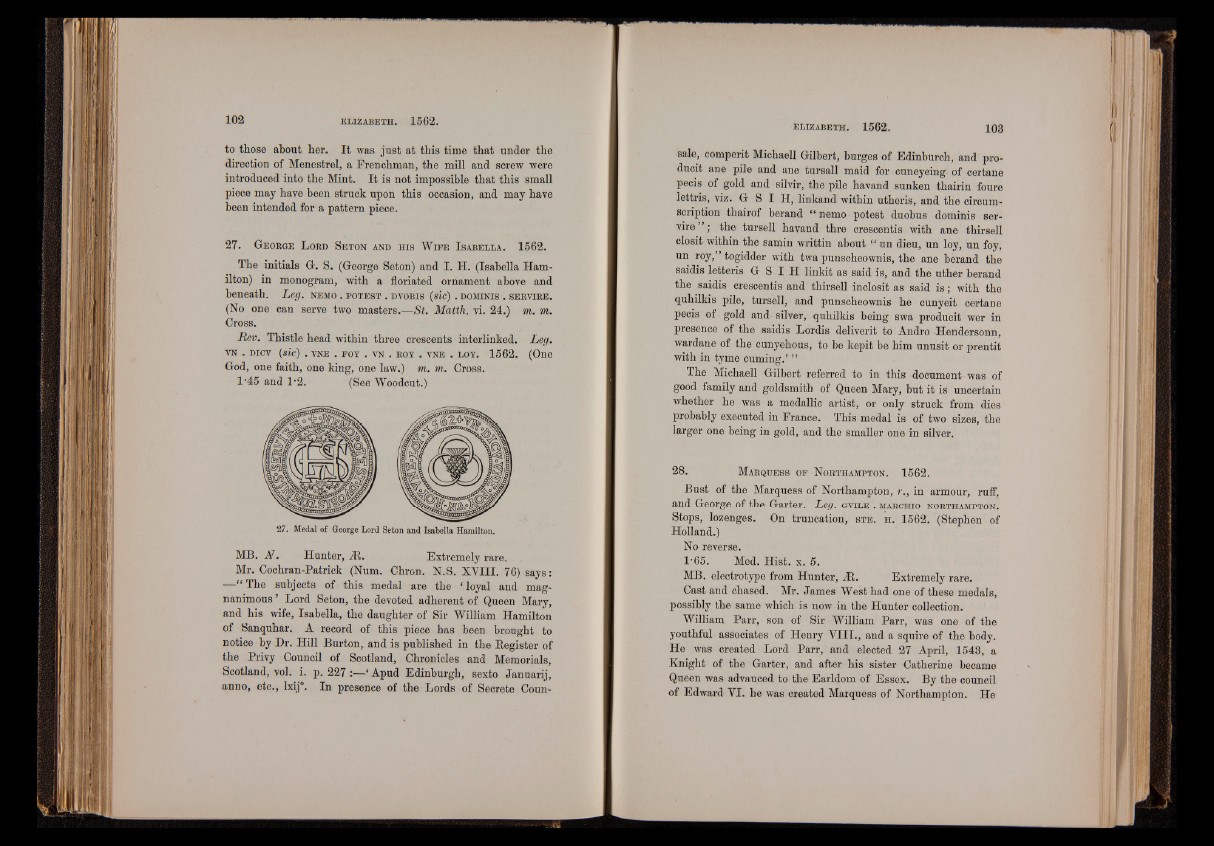
to those about her. It was just at this time that under the
direction of Menestrel, a Frenchman, the mill and screw were
introduced into the Mint. It is not impossible that this small
piece may have been struck upon this occasion, and may have
been intended for a pattern piece.
27. G e o b g e L o b d S e t o n a n d h i s W i f e I s a b e l l a . 1562.
The initials G. S. (George Seton) and I. H. (Isabella Hamilton)
in monogram, with a floriated ornament above and
beneath. Leg. n em o . p o t e s t . d v o b i s (sic). d om in is . s e b v i b e .
(No one can serve two masters.—St. Matth. vi. 24.) m. m.
Cross.
Rev. Thistle head within three crescents interlinked. Leg.
VN . DICV (sic) . VNE . FOY . VN . BOY . VNE . LOY. 1562. (One
God, one faith, one king, one law.) m. m. Cross.
1'45 and l -2. (See Woodcut.)
27. Medal of George Lord Seton and Isabella Hamilton.
MB. N . Hunter, At. Extremely rare.
Mr. Cochran-Patrick (Num. Chron. N.S. XVIII. 76) says:
—“ The subjects of this medal are the ‘ loyal and magnanimous
’ Lord Seton, the devoted adherent of Queen Mary,
and his wife, Isabella, the daughter of Sir William Hamilton
of Sanquhar. A record of this piece has been brought to
notice by Dr. Hill Burton, and is published in the Register of
the Privy Council of Scotland, Chronicles and Memorials,
Scotland, vol. i, p. 227 :—‘ Apud Edinburgh, sexto Januarij,
anno, etc., lxij°. In presence of the Lords of Secrete Counsale,
comperit Michaell Gilbert, burges of Edinburch, and pro-
ducit ane pile and ane tursall maid for cuneyeing of certane
pecis of gold and silvir, the pile havand sunken thairin foure
lettris, viz. G S I H, linkand within utheris, and the circumscription
thairof berand “ nemo potest duobus dominis ser-
vire” ; the tursell havand thre crescentis with ane thirsell
closit within the samin writtin about “ un dieu, un loy, un foy,
un roy,” togidder with twa punschedwnis, the ane berand the
saidis letteris G S I H linkit as said is, and the uther berand
the saidis crescentis and thirsell inclosit as said i s ; with the
quhilkis pile, tursell, and punscheownis he cunyeit certane
pecis of gold and silver, quhilkis being swa producit wer in
presence of the saidis Lordis deliverit to Andro Ilendersonn,
wardane of the cunyehous, to be kepit be him unusit or prentit
with in tyme cuming.’ ”
The Michaell Gilbert referred to in this document was of
good family and goldsmith of Queen Mary, but it is uncertain
whether he was a medallic artist, or only struck from dies
probably executed in France. This medal is of two sizes, the
larger one being in gold, and the smaller one in silver.
28. M a b q t je s s o f N o b t h a m p t o n . 1562.
Bust of the Marquess of Northampton, r., in armour, ruff,
and George of the Garter. Leg. g v i l e . m a b c h io n o b t h a m p t o n .
Stops, lozenges. On truncation, s t e . h . 1562. (Stephen of
Holland.)
No reverse.
1*65. Med. Hist. x. 5.
MB. electrotype from Hunter, At. Extremely rare.
Cast and chased. Mr. James West had one of these medals,
possibly the same which is now in the Hunter collection.
William Parr, son of Sir William Parr, was one of the
youthful associates of Henry VIII., and a squire of the body.
He was created Lord Parr, and elected 27 April, 1543, a
Knight of the Garter, and after his sister Catherine became
Queen was advanced to the Earldom of Essex. By the council
of Edward VI. he was created Marquess of Northampton. He